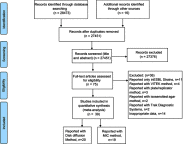Prevalence of antibiotic resistance in Escherichia coli strains simultaneously isolated from humans, animals, food, and the environment: a systematic review and meta-analysis
- PMID: 31190907
- PMCID: PMC6512575
- DOI: 10.2147/IDR.S201324
Prevalence of antibiotic resistance in Escherichia coli strains simultaneously isolated from humans, animals, food, and the environment: a systematic review and meta-analysis
Abstract
Background: Antimicrobial resistance is a serious public health problem worldwide. We aimed to investigate the prevalence of antibiotic resistance in Escherichia coli strains simultaneously isolated from humans, animals, food, and the environment. Methods: Studies on PubMed, Embase, and the Cochrane Library published from January 1, 2000 to January 1, 2018 were searched. The quality of the included studies was assessed by the modified critical appraisal checklist recommended by the Joanna Briggs Institute. All analyses were conducted using Biostat's Comprehensive Meta-Analysis version 2.0. Depending on the heterogeneity test for each antibiotic, we used a random- or fixed-effect model for pooled prevalence of drug resistance. Studies were eligible if they had investigated and reported resistance in two or more isolation sources (human, animal, food, or environment). To decrease heterogeneity and bias, we excluded studies that had reported E. coli drug resistance isolated from one source only. We included publications that reported drug resistance with minimum inhibitory concentration or disk diffusion method (DDM) as antibiotic-susceptibility tests. Results: Of the 39 included studies, 20 used the DDM and 19 minimum inhibitory concentration for their antibiotic-susceptibility testing. Colistin had the lowest prevalence, with 0.8% (95% CI 0.2%-3.8%) and amoxicillin the highest, with 70.5% (95% CI 57.5%-81%) in isolated human E. coli strains tested with the DDM. To assess historical changes in antimicrobial drug resistance, subgroup analysis from 2000 to 2018 showed a significant increase in ciprofloxacin resistance. Conclusion: Monitoring and evaluating antibiotic-sensitivity patterns and preparation of reliable antibiotic strategies may lead to better outcomes for inhibition and control of E. coli infections in different regions of the world.
Keywords: Escherichia coli; antibiotic; drug resistance.
Conflict of interest statement
The authors report no conflicts of interest in this work.
Figures






References
-
- Bryce A, Hay AD, Lane IF, Thornton HV, Wootton M, Costelloe C. Global prevalence of antibiotic resistance in paediatric urinary tract infections caused by Escherichia coli and association with routine use of antibiotics in primary care: systematic review and meta-analysis. BMJ. 2016;352:i939. doi:10.1136/bmj.i1717 - DOI - PMC - PubMed
-
- Bonnedahl J, Drobni P, Johansson A, et al. Characterization, and comparison, of human clinical and black-headed gull (Larus ridibundus) extended-spectrum β-lactamase-producing bacterial isolates from Kalmar, on the southeast coast of Sweden. J Antimicrob Chemother. 2010;65(9):1939–1944. doi:10.1093/jac/dkq222 - DOI - PubMed
-
- Boonyasiri A, Tangkoskul T, Seenama C, Saiyarin J, Tiengrim S, Thamlikitkul V. Prevalence of antibiotic resistant bacteria in healthy adults, foods, food animals, and the environment in selected areas in Thailand. Pathog Glob Health. 2014;108(5):235–245. doi:10.1179/2047773214Y.0000000148 - DOI - PMC - PubMed
Publication types
LinkOut - more resources
Full Text Sources

